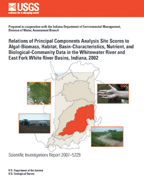Publications—Scientific Investigations Report 2007-5229
By Brian J. Caskey, Jeffrey W. Frey, and B. Scott Lowe
 |
This Report is available Online Only Front Cover - PDF format (897 KB)
|
Data were gathered from May through September 2002 at 76 randomly selected sites in the Whitewater River and East Fork White River Basins, Indiana, for algal biomass, habitat, nutrients, and biological communities (fish and invertebrates). Basin characteristics (land use and drainage area) and biolog-ical-community attributes and metric scores were determined for the basin of each sampling site. Yearly Principal Compo-nents Analysis site scores were calculated for algal biomass (periphyton and seston). The yearly Principal Components Analysis site scores for the first axis (PC1) were related using Spearman’s rho to the seasonal algal-biomass, basin-charac-teristics, habitat, seasonal nutrient, and biological-community attribute and metric score data.
The periphyton PC1 site score was not significantly related to the nine habitat or 12 nutrient variables examined. One land-use variable, drainage area, was negatively related to the periphyton PC1. Of the 43 fish-community attributes and metrics examined, the periphyton PC1 was negatively related to one attribute (large-river percent) and one metric score (car-nivore percent metric score). It was positively related to three fish-community attributes (headwater percent, pioneer percent, and simple lithophil percent). The periphyton PC1 was not statistically related to any of the 21 invertebrate-community attributes or metric scores examined.
Of the 12 nutrient variables examined two were nega-tively related to the seston PC1 site score in two seasons: total Kjeldahl nitrogen (July and September), and TP (May and September). There were no statistically significant relations between the seston PC1 and the five basin-characteristics or nine habitat variables examined. Of the 43 fish-community attributes and metrics examined, the seston PC1 was positively related to one attribute (headwater percent) and negatively related to one metric score (large-river percent metric score) . Of the 21 invertebrate-community attributes and metrics exam-ined, the seston PC1 was negatively related to one metric score (number of individuals metric score).
To understand how the choice of sampling sites might have affected the results, an analysis of the drainage area and land use was done. The sites selected in the Whitewater River Basin were generally small drainage basins; compared to Whitewater River Basin sites, the sites selected in the East Fork White River Basin were generally larger drainage basins. Although both basins were dominated by agricultural land use the Whitewater River Basin sites had more land in agriculture than the East Fork White River Basin sites.
The values for nutrients (nitrate, total Kjeldahl nitrogen, total nitrogen, and total phosphorus) and chlorophyll a (per-iphyton and seston) were compared to published U.S. Environmental Protection Agency (USEPA) values for Aggregate Nutrient Ecoregions VI and IX and USEPA Level III Ecore-gions 55 and 71. Several nutrient values were greater than the 25th percentile of published USEPA values. Chlorophyll a (periphyton and seston) values were either greater than the 25thpercentile of published USEPA values or they extended data ranges in the Aggregate Nutrient and Level III Ecore-gions. If the values for the 25th percentile as proposes by the USEPA were adopted as nutrient water-quality criteria, many samples in the Whitewater River and East Fork White River Basins would have exceeded the criteria.
Abstract
Introduction
Purpose and Scope
Description of the Whitewater River Basin
Description of the East Fork White River Basin
Study Methods
Site Selection and Sampling Strategies
Algal-Biomass, Habitat, Nutrient, and Biological-Community Data-Collection and Processing Methods
Data Analysis
Basin-Characteristics Data
Nutrient Data
Principal Components Analysis
Comparison With U.S. Environmental Protection Agency Data
Relations of the Principal Components Analysis Site Scores to Algal-Biomass, Habitat, Basin-Characteristics, Nutrient, and Biological-Community Data
Drainage-Area and Land-Use Analysis
Comparison of the Data to Ecoregion Nutrient Criteria
Conclusions
Acknowledgments
References
Appendix 1
Caskey, B.J., Frey, J.W., and Lowe, B. S., 2007, Relations of Principal Component Analysis site scores algal-biomass, habitat, basin-characteristics, nutrient, and biological community data in the Whitewater River and East Fork White River Basin, Indiana, 2002: U.S. Geological Survey Scientific Investigations Report 2007–5229, 31 p.
If you have Adobe Acrobat® or Adobe Acrobat Reader® installed on your computer, you may view and print the PDF version of this report. Acrobat Reader, is a free download from Adobe Systems, Inc. Users with disabilities can view information concerning accessibility at access.Adobe.com .